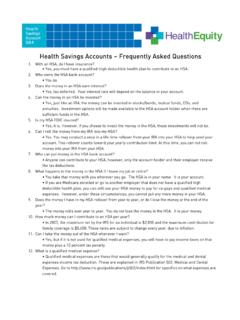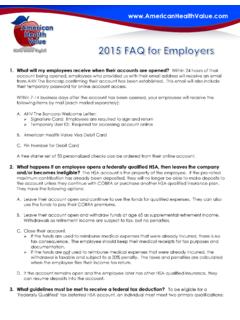Transcription of ERISA and Employee Welfare Benefits: When ERISA Applies ...
1 ERISA and Employee Welfare benefits : when ERISA Applies and What That Means The Employee Retirement Income Security Act of 1974 ( ERISA ) is a federal law that sets minimum standards of protection for individuals participating in most Employee benefit plans. To achieve that purpose, ERISA places specific requirements on plan sponsors and administrators, many of which directly affect employers. In addition to the more well-known requirements relating to summary plan descriptions (SPDs) and Form 5500 reporting, ERISA . imposes other filing and notification obligations, claims procedures and recordkeeping requirements, and a strict fiduciary code of conduct on those who sponsor and administer ERISA plans. This white paper focuses generally on how ERISA might apply to a plan-sponsoring employer, and how such an employer may ensure compliance with its ERISA obligations.
2 This paper does not describe every requirement or exception provided under ERISA or how ERISA might apply to a specific plan or specific set of facts or circumstances. Employers are therefore encouraged to consult outside counsel with respect to their specific ERISA obligations. This white paper outlines the following: The types of plans subject to ERISA . The specific ERISA requirements that apply to such a plan What a wrap document is Employer action items for ERISA compliance Penalties for ERISA noncompliance Frequently asked questions relating to ERISA 's requirements Additional resources to assist employers in ERISA compliance efforts To Which Plans Does ERISA Apply? Generally, ERISA Applies to all Employee Welfare benefit plans, defined under ERISA as a plan, fund or program that is established or maintained by an employer for the purposes of providing specifically listed benefits , through the purchase of insurance or otherwise, to participants and their Most employer-sponsored group health plans, whether fully or self-insured, will constitute an Employee Welfare benefit plan subject to ERISA .
3 Below is a chart outlining various plans, and whether they are subject to ERISA : White Paper continues >. Page 2 of 8 White Paper ERISA and Employee Welfare benefits : when They Apply and What That Means Type of Plan Subject to ERISA ? Dental plan Yes Dependent care assistant program (DCAP) No Disability insurance (short-term or long-term) Yes Group term life insurance Yes Major medical health insurance Yes health FSA Yes health maintenance organization (HMO) Yes health reimbursement arrangement (HRA) Yes health savings account (HSA) No Mini-med/limited benefit plan Yes Prescription drug plan Yes Vision Yes That said, there are a number of exceptions to ERISA . For example, governmental plans (including state, city and county plans, public schools and school districts), church plans, and plans maintained solely to comply with state workers'.
4 Compensation, unemployment or disability laws are all generally exempt from Also exempt are plans maintained outside of the primarily for the benefit of resident alien There is no general exception to ERISA for small employers; rather, ERISA generally Applies to all sizes of employers, unless another exception Applies . Under Department of Labor (DOL) regulations, certain payroll practices and so-called voluntary plans are exempt from ERISA . Payroll Practice Exemption By virtue of the DOL regulations, certain types of employer-provided benefits may qualify for the so-called payroll practice exemption from ERISA . Generally, a payroll practice is a benefit payment made by the employer solely out of the employer's general It is important to note that insured plans fall outside the payroll practice safe harbor, since payment of benefits through insurance is not payment from the employer's general assets.
5 In addition, plans that cover former employees, including disabled retirees or those otherwise terminated from employment, also fall outside the payroll practice safe Voluntary Plan Exemption There is also a safe harbor in the regulations for certain voluntary insurance arrangements under which employees pay the full premium and the employer has minimal Commonly referred to as voluntary plans, these arrangements include both group and individual insurance policies. Some of the types of policies sold as voluntary plans include life and disability insurance, dental insurance, long-term care insurance and some types of medical bridge insurance that pay for certain medical issues ( , extended hospital stays, specified illness or cancer treatment).
6 Specifically, under the regulations, the term Employee benefit Welfare plan does not include group insurance if the sole functions of the employer are to permit an insurer to publicize a program to employees, to collect premiums through payroll deductions and to remit premiums to the insurer, and if the employer does not endorse the program, contribute premiums to the insurer or profit from the In addition, the plan must be completely voluntary, meaning that the employer cannot put any conditions on the election of the benefits . Under the endorsement requirement, the insurance company, not the employer, must be the entity offering the plan. Any involvement by the employer beyond permitted activities in connection with premium/payroll deductions may place the arrangement outside of the exemption.
7 Some of the actions by the employer seen as endorsement include: 1) assisting employees with preparation of claims forms; 2) negotiating with insurers; 3) record keeping (other than maintaining a list of enrolled employees); and 4) allowing payroll deductions to be made on a pretax basis under an employer's cafeteria plan. To reinforce this last point, to qualify for the voluntary plan exemption, the premium for the plan can be deducted from payroll, but cannot be taken on a pretax basis (through the employer's cafeteria plan). Assuming the plan does not satisfy one of the above exceptions, the plan would be subject to ERISA . This means the employer, as plan sponsor, would become subject to additional compliance requirements under ERISA , and a failure to Page 3 of 8 White Paper ERISA and Employee Welfare benefits : when They Apply and What That Means comply with ERISA obligations could result in substantial liability for the employer.
8 Outlined below are the primary ERISA . requirements with which an employer would need to comply. ERISA Requirements for Employer-sponsored Group health Plans Written Plan Document ERISA requires that every Welfare plan be established and maintained pursuant to a written instrument. This Applies to all ERISA plans, regardless of size. This is so that each plan participant can look at the written plan document and definitively determine their benefits , rights, and obligations. The plan document also helps outline how the plan administrator makes decisions and operates the plan. Nevertheless, an ERISA plan can exist without a written plan document; it just exists in violation of the written plan document requirement. The written plan document must include a description of benefits , eligibility, benefit funding methods, and plan amendment and termination procedures.
9 The document must also designate a named fiduciary plan administrator, and plan name, year and number (important for Form 5500 filings, as outlined below). While there is no requirement to distribute the written plan document, it must be provided to participants and beneficiaries within 30 days of a written request. If a plan administrator does not adhere to this requirement, it could be subject to a penalty of $110 per day. One way that an employer can satisfy the written plan document requirement is through a wrap document or mega-wrap document. A wrap document is generally used by a fully insured plan to supplement an insurance policy or similar third- party contract by wrapping itself around the document and supplying the ERISA bells and whistles.
10 This is the typical way of supplementing an insurance company's certificate of coverage with the missing ERISA provisions, and is the option that employers should use when they do not want to produce an entirely new written plan document. A mega-wrap document is similar to a wrap document in that it supplements the underlying document by adding the appropriate ERISA required items. However, it also collects documents regarding more than one type of benefit option together to form a single plan. For example, if an employer sponsors a major medical plan, an FSA, an HRA and a dental plan, the employer could use a mega-wrap document to bundle all four of the component benefit plans together as one plan for ERISA purposes. Please note that a plan sponsor will not necessarily want to include a component plan with fewer than 100 participants in a mega-wrap plan.





